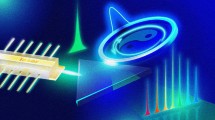Abstract
Mode locking phenomena in acoustics and in laser physics are discussed and are shown to share a feature of the forced oscillator: Oscillation takes place at the forcing frequency (or frequencies). The phenomena differ from simple forced oscillations in that they involve sustained oscillators (e.g., clocks, lasers) whose sustaining sources compete against the forcing signals in the choice of oscillation frequency. The locking phenomena are compared to second-order phase transitions in ferromagnetism and superconductivity where corresponding competition occurs between disordering thermal fluctuations and ordering correlations which reduce system energy.
Similar content being viewed by others
References
Société Hollandaise des Sciences,Oeuvres complètes de Christian Huygens (Martinus Nijhoff, La Haye 1893), Vol. 5, pp. 243–244
Ref. [1],, pp. 255–256
Rayleigh (Lord): Phil. Mag.13, 316 (1907)
B.van derPol: Radiol. Rev.1, 704 (1920)
B.van derPol: Phil. Mag.3, 65 (1927) (See also his review article, Proc. IRE22, 1051 (1934))
W.E.Lamb,Jr.: Phys. Rev.134, 1429 (1964)
N.Minorsky:Nonlinear oscillations (Van Nostrand, Princeton, N. J. 1962), Chap. 18
R. Lang, M.O.Scully, W.E.Lamb,Jr.: Phys. Rev. (to be published)
W.R.Bennett,Jr.: Phys. Rev.126, 580 (1962)
F.Aronowitz, R.J.Collins: Appl. Phys. Letters9, 55 (1966)
M.Sargent III, M.O.Scully: Theory of Laser Operation, in:Laser Handbook, Eds. F.T.Arecchi and E.O.Schultz-DuBois (North-Holland, Amsterdam 1972) pp. 45–114
M.SargentIII, W.E.Lamb,Jr., R.L.Fork: Phys. Rev.164, 450 (1967)
L.E.Hargrove, R.L.Fork, M.A.Pollack: Appl. Phys. Letters5, 4 (1964)
H.W.Mocker, R.J.Collins: Appl. Phys. Letters7, 270 (1965)
A.J.DeMaria, D.A.Stetser, H.Heynau: Appl. Phys. Letters8, 174 (1966)
C.C.Cutler: Proc. IRE43, 140 (1955)
V.S.Letokhov: Soviet Phys. JETP28, 562 (1969) (In this paper, the “minipulse” of peak power is said to build up rather than the group of minipulses that concentrates the greatest energy in the short absorber relaxation time. According to F. A. Hopf, it is the latter that effects the absorber)
S.E.Harris, O.P.McDuff: IEEE J. Quantum ElectronicsQE-1, 245 (1965) FM operation was observed by E. O. Ammann, B.J. McMurtry, M.K.Oshman: IEEE J. Quantum ElectronicsQE-1, 263 (1965)
A.G.Fox, T.Li: Bell System Tech. J.40, 453 (1961); Proc. I.R.E.48, 1904 (1961)
G.D.Boyd, J.P.Gordon: Bell System Tech. J.40, 489 (1961)
R.J.Glauber: Phys. Rev.131, 2766 (1963)
D.H.Auston: IEEE J. Quantum ElectronicsQE-4, 420 and 471 (1968)
P.W.Smith: Proc. IEEE58, 1342 (1970) Among the papers published since this review article, notably those dealing with Nd:YAG, are a series by D.J.Kuizenga, A.E.Siegman: IEEE J. Quantum ElectronicsQE-6, 673, 694, 709, and 803 (1970); and one reporting the continuous, 1-psec pulse trains in a dye laser with a saturable absorber by C.V. Shank, E.P.Ippen, and A.Dienes, paper B.3, International Quantum Electronics Conference, Montreal 1972
V.DeGiorgio, M.O.Scully: Phys. Rev.A2, 1170 (1970)
R.Graham, H.Haken: Z. Physik237, 31 (1970)
M.O.Scully, personal communication to the author
See, for example, S.Chandrasekhar,Hydrodynamik and hydromagnetic stability (Clarendon Press, Oxford 1961) pp. 652
R.Graham, in Proceedings of the Third (1972) Rochester Conference on Coherence and Quantum Optics; another paper to be published
M.O.Scully, in Proceedings of the Third (1972) Rochester Conference on Coherence and Quantum Optics
Author information
Authors and Affiliations
Rights and permissions
About this article
Cite this article
Sargent, M. Mode locking in quantum optics. Appl. Phys. 1, 133–139 (1973). https://doi.org/10.1007/BF00889543
Received:
Issue Date:
DOI: https://doi.org/10.1007/BF00889543




